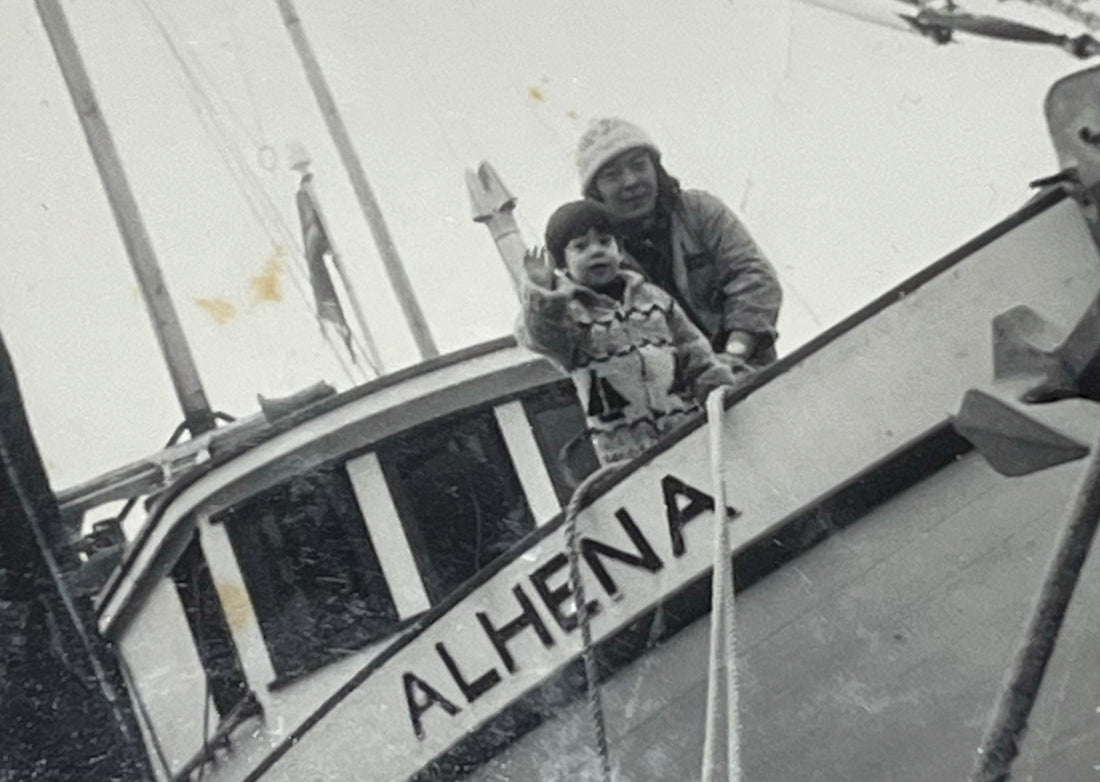
Exploring the History of Japanese Canadians in Ucluelet
Share
Feature Image:
Katsumi & Gord 1979
Acknowledgment of Territory
First and foremost, I wish to humbly acknowledge that we are on the traditional territory of the Yuułuʔiłʔatḥ First Nation. Their stewardship and enduring connection to this land remind us of the need to honour its history and cultural significance.
A Grant for Artistic Reflection
This past spring, I was thrilled to receive an Arts Grant from the Japanese Canadian Legacy Society (JCLS). The grant supports my project, The Missing Link, a series of artworks exploring my Great-Grandfather's fishing boat of the same name and the regional history of our family along the west coast. This journey encompasses Tofino, Clayoquot Sound, and Ucluelet—our family’s home for the past 75 years.
Since receiving the grant, I’ve begun sketching areas around Ucluelet and its surroundings, immersing myself in the rich natural and cultural heritage of the region. Adding to this artistic endeavour, I had the privilege of collaborating with the Ucluelet & Area Historical Society (UAHS) to host a series of Historical Harbour Tours this summer.

Historic Harbour Tours - Photo compliments of UAHS
Personal Engagement with History
My family and I attended one of these historic harbour tours last summer, and even as a long-time local, I found it deeply enriching. The tours shed light on the intricate history of the area, particularly the experiences of Japanese Canadian settlers who lived in Ucluelet before World War II and the tragic events surrounding the mass incarceration of 22,000 Japanese Canadians during the war. Although I already knew a great deal about my family’s and Grandparents experience during that time, I did not know a lot about the different JC settlements around the inlet, nor the names and stairs that went with them.
Between 1914 and 1930, Japanese Canadians formed a significant part of Ucluelet’s population, a one time even outnumbering both Indigenous and white settlers—a demographic shift that was also a result of the devastating impacts of colonialism on Indigenous populations. This Japanese Canadian community was vibrant and industrious, forming six main settlements: Sunahama, Bunji Bay, Fraser’s Bay, Spring Cove, Hakoda Bay, and Shimizu Bay.

Spring Cove 1914 Seriagraph Print
Spring Cove 2000 Seriagraph Print
The Vibrancy of Spring Cove
Spring Cove, where my grandparents eventually settled in 1950, was once the heart of a thriving Japanese Canadian community. It housed three stores, numerous homesteads, a lifeboat station, and served as a hub for fishing and community events. Notably, Dominion Day celebrations brought together First Nations, white settlers, and Japanese Canadians in shared festivities—a poignant reminder of the possibilities of multicultural unity.
However, this thriving community faced a devastating blow in 1942, when the Canadian government forcibly removed all Japanese Canadians from the west coast. Families were given just 24 hours to pack two suitcases before being relocated to internment camps. Most lost their homes, fishing boats, and most of their worldly personal belongings, and many never returned to their coastal communities. In Ucluelet, only one Japanese Canadian family, the Nitsui’s, lived there before the war and managed to resettle there after the war.
Transformations at Spring Cove
During World War II, Spring Cove was repurposed as a Canadian military training ground, with existing Japanese Canadian homes and infrastructure adapted for military use. My grandparents moved to Spring Cove in 1950 and initially lived in what had been the military’s meal hall. I remember visiting this unique home as a child, wondering at their living rooms spacious design—a vestige of its military past.
 Mass Evacuation / Incarceration 1942 Seriagraph Print
Mass Evacuation / Incarceration 1942 Seriagraph Print
Reflections and New Discoveries
Hosting the Historical Harbour Tours this summer has been a profound honour. Through these experiences, I deepened my understanding of local history, uncovering stories of resilience, loss, and an extensive community that had remained hidden from me despite my lifelong connection to the area.
Special Thanks
This journey of artistic and historical exploration has been made possible through the generous support and collaboration of several organizations and individuals. My heartfelt gratitude goes to:
- The Japanese Canadian Legacy Society (JCLS) for their funding and unwavering support of my project, The Missing Link.
- The Ucluelet & Area Historical Society (UAHS) for providing invaluable historical accounts, records, and readings for the tours, and to all those Legends who shared their stories.
- Subtidal Adventures and the Dixie IV for their sponsorship and logistical support in making the Historical Harbour Tours a success.
- Clayoquot Biosphere Trust (CBT) and the Alberni-Clayoquot Regional District for their additional support and sponsorship.
This collective effort has brought new life to the history of Japanese Canadians in Ucluelet and enriched my understanding of the area's cultural fabric.
As I continue work on The Missing Link, I carry forward the stories, connections, and inspirations gained from this remarkable journey. Through art and shared narratives, I hope to honour the past while fostering a deeper appreciation for the rich history of our community.
